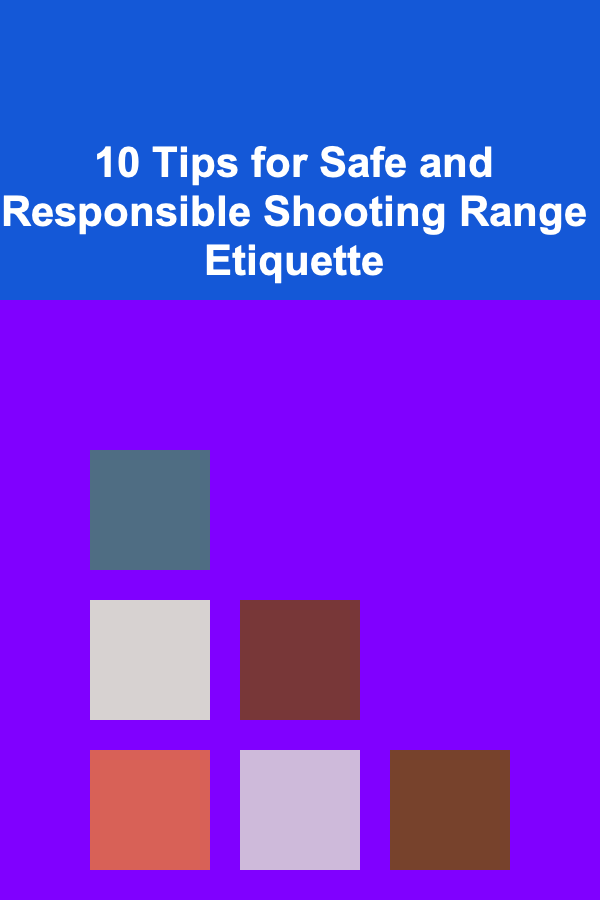
10 Tips for Safe and Responsible Shooting Range Etiquette
ebook include PDF & Audio bundle (Micro Guide)
$12.99$5.99
Limited Time Offer! Order within the next:

Shooting ranges are places where enthusiasts, professionals, and even novices can practice and improve their shooting skills in a controlled environment. Whether you're a seasoned shooter or new to firearms, safety and proper etiquette are paramount. Understanding and adhering to these guidelines not only ensures your safety but also the safety of others sharing the range with you.
While shooting can be a thrilling and rewarding activity, it's essential to approach it with responsibility and respect for the rules and other shooters. To help you navigate the range safely and responsibly, here are 10 crucial tips on shooting range etiquette.
Always Follow Safety Rules
Safety is the top priority when visiting a shooting range. Every range has a set of rules and regulations that are there to protect you, others, and the equipment. These rules may vary depending on the range, but there are some universal safety practices you should always follow:
- Keep your firearm pointed downrange at all times. Never point a firearm at anything other than the target.
- Keep your finger off the trigger until you are ready to shoot.
- Treat every firearm as if it's loaded. Even if you know it's unloaded, always treat it with respect.
- Ensure your firearm is safely stored when not in use. Use a holster, bag, or designated area to keep it secure when not actively shooting.
Being vigilant about these safety basics can prevent accidents and help you create a safe environment for everyone at the range.
Wear the Proper Safety Gear
Safety gear is a non-negotiable requirement when shooting at the range. A few essential items are necessary to protect yourself from potential hazards:
- Ear protection: The sound of gunfire is extremely loud and can cause hearing damage over time. Both earplugs and earmuffs can provide protection. Some ranges require both for maximum protection.
- Eye protection: Flying debris from fired rounds or misfires can cause serious eye injuries. Always wear safety glasses, even if you're shooting at an indoor or covered range.
- Proper clothing: Wear closed-toe shoes and clothes that will protect your skin from hot brass casings that may eject during shooting.
When it comes to safety, don't take shortcuts. Make sure you're equipped with the necessary protective gear every time you step onto the range.
Respect the Range Commands
Most ranges operate on a strict protocol of verbal commands or signals that help maintain safety. Ignoring these commands can lead to dangerous situations. Be sure to listen carefully and obey any instructions given by the range officer or other authorized personnel.
Common commands may include:
- "Ceasefire": This typically means that everyone must stop shooting immediately. You should remain in your shooting position with your gun safely pointed downrange until the ceasefire is lifted.
- "Clear your weapon": This command instructs shooters to unload and inspect their firearms for safety before stepping away from the shooting lane.
- "Line is hot": This means it's safe to shoot, and all shooters should aim and fire.
Whether it's a verbal command or a signal, be sure you understand the range's specific protocol and always follow the instructions without hesitation.
Know Your Firearm and Practice Proper Handling
Before using any firearm at the range, ensure that you are thoroughly familiar with its operation. Whether you're using your own firearm or one rented from the range, it's essential to understand how it functions.
- Safety features: Learn how to engage and disengage the safety, as well as how to load and unload the firearm correctly.
- Shooting posture: Practice your stance and grip to ensure you handle the gun safely and accurately.
- Malfunctions: Understand how to clear any misfires or malfunctions in a safe and controlled manner.
Proper firearm handling is key to not only improving your accuracy but also ensuring your safety and the safety of those around you.
Use Only Approved Ammunition
When shooting at a range, it's critical to use only the approved ammunition for your firearm. Each range will have specific guidelines on what type of ammunition is allowed. Using the wrong ammunition can cause malfunctions or even accidents.
- Check your ammo: Make sure the ammunition you're using is compatible with your firearm.
- Follow the range's rules: Some ranges do not permit high-powered or tracer ammunition, so make sure you check the rules before bringing your own rounds.
Using the correct ammunition ensures a smoother, safer experience for you and all the other shooters at the range.
Be Mindful of Your Shooting Lane
At shooting ranges, especially those with multiple shooters, it's important to respect your designated shooting lane. The boundaries of your lane are not just arbitrary---they are there to keep you and others safe.
- Stay within your lane: Do not lean into or cross over to other shooting lanes. Maintain a safe distance from other shooters.
- Keep your gun in a safe position: When you're not actively shooting, always keep your firearm safely pointed in a direction where it cannot accidentally harm anyone.
- Share the space: Be mindful of others sharing the range. Avoid distractions and don't take up more space than necessary.
Being conscious of your own shooting lane minimizes risks and maintains a safe environment for everyone on the range.
Clean Up After Yourself
While it's common to think of shooting ranges as places for individuals to focus on their shooting skills, it's also important to leave the range in the condition you found it. Many shooters may leave behind spent brass casings, targets, and other debris, but this can create a hazard for other users.
- Pick up your brass: If you're shooting at an outdoor range, it's courteous to collect any spent brass casings or other discarded items after each shooting session.
- Dispose of waste properly: If you have targets, packaging, or any other trash, be sure to dispose of it in the provided bins.
- Leave your lane clean: Tidy up the shooting area and return any shared equipment, like target stands, to their proper place.
A well-maintained shooting range ensures a more pleasant experience for everyone and helps preserve the facility for future use.
Be Considerate of Other Shooters
At a shooting range, you'll likely encounter a diverse group of people, from novices to experts. It's essential to be considerate of your fellow shooters to ensure a positive and cooperative environment.
- Keep your noise level down: While it's understandable that shooting can be loud, excessive shouting, talking, or distractions can disrupt others. Speak in a low voice and be mindful of the noise level.
- Wait for the range to be clear: Never shoot if there's a possibility that someone may be downrange, even if they're at a distance.
- Don't monopolize the range: If you're using a public range, be considerate of others waiting to shoot. If you're practicing for extended periods, be aware of how long you've been at your lane, and allow others the opportunity to use the facility.
By respecting your fellow shooters, you contribute to a positive atmosphere at the range.
Avoid Handling Firearms When Not Necessary
Handling firearms unnecessarily increases the risk of accidental discharges and other safety issues. Here are some common guidelines:
- Only handle your firearm when it's your turn to shoot: Don't load, unload, or adjust your gun when you're not actively shooting.
- Use the designated areas for handling firearms: Most ranges have specific areas for handling your gun, such as a bench or designated gun rack.
- Ask for help if you're unfamiliar: If you're unsure about a firearm or how to handle it, don't hesitate to ask a range officer for guidance.
Minimizing unnecessary firearm handling ensures a safer range environment for everyone.
Practice Good Sportsmanship
Lastly, remember that the shooting range is a place for improvement, learning, and enjoyment. Whether you're practicing on your own or competing in friendly matches, maintaining a positive and respectful attitude is important.
- Respect other shooters' skills and experience: Every shooter is at a different level of ability. Be patient with others, especially beginners.
- Don't judge others' shooting: Keep your opinions about other shooters' performance to yourself. Constructive feedback is fine, but unsolicited advice or criticism can be unwelcome.
- Have fun and stay relaxed: Shooting should be enjoyable, so make sure to stay calm, have fun, and not get frustrated by challenges.
A range where everyone practices good sportsmanship is a place where everyone can grow and enjoy the activity in a safe, respectful atmosphere.
Conclusion
Shooting range etiquette is all about prioritizing safety, respecting others, and following the range's rules and guidelines. By adhering to the tips outlined above, you contribute to a safer and more enjoyable experience for everyone at the range, whether you're a seasoned shooter or just starting out.
Remember, safety should always be your top priority. By understanding and practicing responsible shooting etiquette, you'll help maintain a positive atmosphere at the range while ensuring that your experiences, as well as the experiences of others, are both enjoyable and safe.
Reading More From Our Other Websites
- [Organization Tip 101] How to Create a Family Calendar Display in Your Dining Room
- [Home Cleaning 101] How to Clean Your Floors Based on Material Type
- [Rock Climbing Tip 101] Must-Know Rope Techniques Every Climber Should Master
- [Home Space Saving 101] How to Organize Your Closet for Maximum Space
- [Toy Making Tip 101] Beyond Store-Bought: Transforming Everyday Materials into Unique Toys
- [Skydiving Tip 101] Saving Money on Skydiving: Tips to Cut Costs Without Compromising Safety
- [Organization Tip 101] How Smart Thermostat Installation Can Improve Your Home's Climate Control
- [Home Renovating 101] How to Renovate Your Living Room for a Stylish and Functional Space
- [Personal Care Tips 101] How to Keep Your Skin Glowing with Simple Personal Care Tips
- [Home Rental Property 101] How to Prepare Your Home for Rent to Attract Top-Tier Tenants

How to Create a Warm and Inviting Holiday Atmosphere with Candles
Read More
How to Make Family DIY Projects Fun and Engaging for Everyone
Read More
How to Use Checklists for Home Organization
Read More
Practical Tips for Cutting Down on Impulse Online Shopping
Read More
How to Declutter Your Books and Media Collection: A Deep Dive
Read More
How to Fly Fish for Trout in Mountain Streams
Read MoreOther Products

How to Create a Warm and Inviting Holiday Atmosphere with Candles
Read More
How to Make Family DIY Projects Fun and Engaging for Everyone
Read More
How to Use Checklists for Home Organization
Read More
Practical Tips for Cutting Down on Impulse Online Shopping
Read More
How to Declutter Your Books and Media Collection: A Deep Dive
Read More